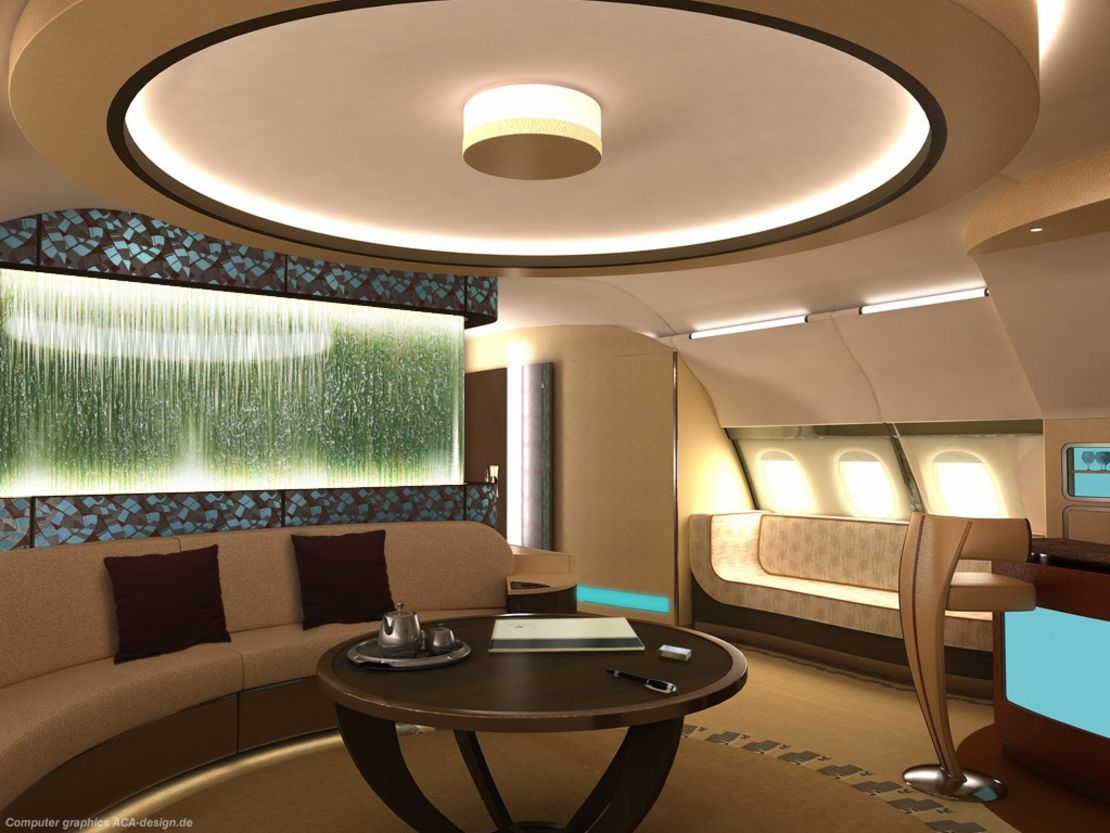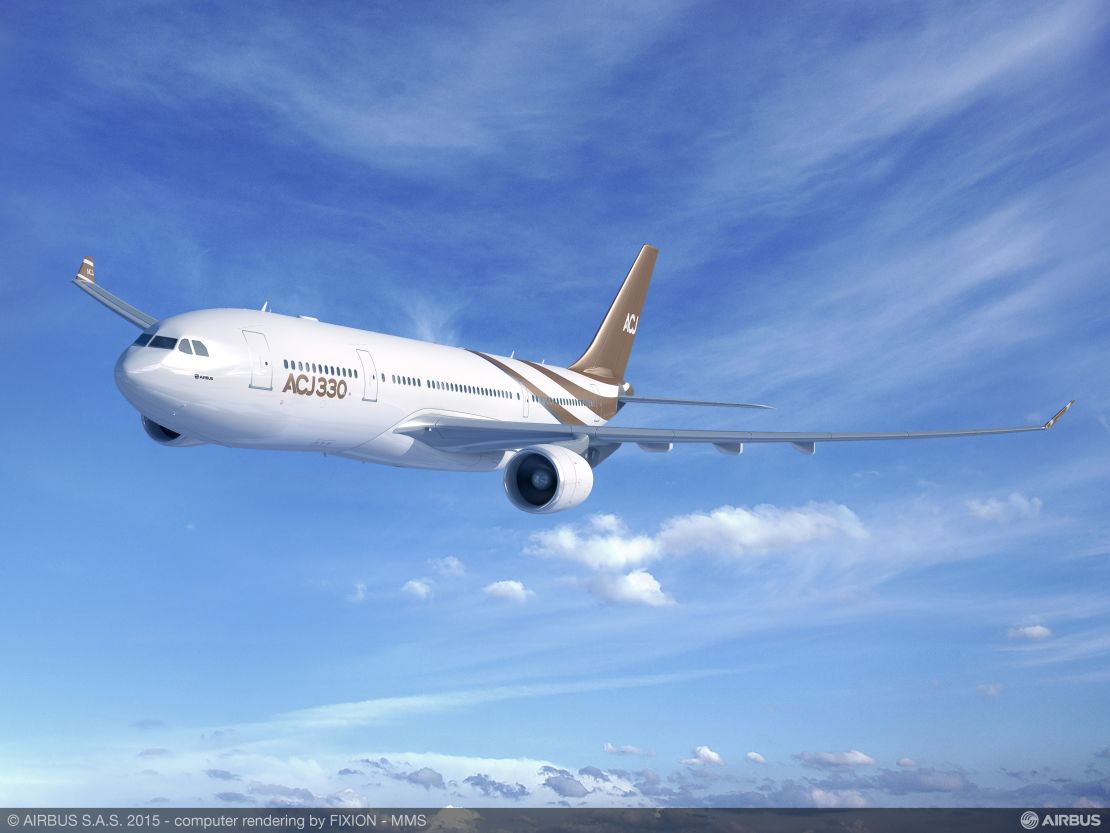A contemporary-style bedroom with a touch of classical elegance, complete with king-size bed and designer furniture, Champagne at the ready and magnificent panoramic views.
It could be a five-star hotel suite, but this is actually the cabin of an Airbus A330 VIP, nothing less than a full-on $200 million flying palace.
This aircraft, outfitted by Comlux, a Swiss firm specializing in the design, outfitting and operation of large corporate jets, represents the state of the art when it comes to luxury aircraft cabin design.
You can see three animated renderings from the A330’s interior below.
The last couple of decades have seen a dramatic increase in the number of billionaires and multimillionaires worldwide, driving the demand for ever more luxurious ways to jet around the world.
While private jets come in all shapes and sizes, the ultimate status statement is the VIP airliner.
A very special market
To cater to this market, the major aircraft manufacturers have developed corporate versions of their best-selling airliners.
Boeing has the Boeing Business Jet (BBJ) family while its European rival has the Airbus Corporate Jet (ACJ).
Their product ranges includes specially configured variants of the popular Airbus A320 and Boeing 737, but the most deep-pocketed buyers can also order larger models, such as the Boeing 747 and Airbus A340 or the newest Boeing 787 and Airbus A350.
These firms have created specific departments to serve this very special clientele.
“It makes sense for companies like Airbus and Boeing to have a separate organization in order to cater to VIP clients.
“This market is all about emotion. It is not unusual for a client to call you in the middle of the night to discuss this or that detail of his aircraft decor,” says Richard Gaona, an industry veteran who, after many years at the helm of Airbus Corporate Jets, is now CEO of Comlux.
There are currently some 300 converted VIP-configured airliners flying around the globe.
Some of them belong to governments, who use them to fly heads of state and their entourages.
Air Force One is probably the most famous, but other countries have their own presidential aircraft too.
Large corporations and ultra-rich individuals are also a market for this topflight segment of private aviation.
“Some of the people that fly in these large corporate jets may own already a smaller aircraft for their solo business trips, but may buy or rent a larger aircraft for when they travel with the family or a larger entourage,” adds Gaona.
Luxury rental
The individuals and corporations who own these craft may entrust a company such as Comlux with the everyday crewing, maintenance and paperwork, but also with the mandate to rent it out if the opportunity arises.
This allows them to make some extra money out of their very expensive aircraft whenever they’re not using them. It’s not unlike homeowners who temporarily rent out their own homes on Airbnb.
“We would get a request from anywhere in the world and then consult with the aircraft owner to get approval. Some aircraft owners are very protective of the privacy of their aircraft – they see it as an extension of their home – but there are other owners that welcome the chance to get an additional return on their assets,” says Gaona.
Performance at all costs
Although they share the airframe with commercial airliners, the market for very large corporate jets is driven by totally different considerations.
Whereas an airline would look first of all at the economics of an aircraft and its operational efficiency, private clients tend to be more interested in raw performance.
The Boeing 767 BBJ outfitted by Comlux, for example, is able to carry up to 60 people in total comfort, and stay in the air for over 17 hours without refueling.
“For our clients it is range and capacity that matter,” says David Velupillai, head of marketing for Airbus Corporate Jets. “Heads of state, for example, value the capacity to travel to distant countries without being forced to stop over along the way.”
Governments that don’t have a dedicated presidential fleet, such as those of most small countries, often resort to the rental market to fly their delegations to far-flung international summits.
“When there is the UN Annual General Assembly, some governments come to us to get them to New York,” says Gaona. “It may appear sumptuous, but once you factor in the cost of the alternatives, the time saved by a direct flight and security considerations, it can be a good value option and way cheaper and more acceptable to public opinion than buying your own presidential jet.”
Large jets are also favored by other segments of the market.
“Music bands, the film industry or sports teams often need to move not just a bunch of people but also tons of specialized equipment from one city to the next.
“In many cases there are not even commercial flights available that would suit the hectic schedules of a music tour or a sports tournament. In these circumstances, chartering a large private jet may be a very reasonable option,” explains Adam Twidell, CEO and Founder of PrivateFly, an executive jet operator and broker based in the UK.
Palatial interiors
While their technical performance is impressive, for the majority of people the most eye-catching element of any VIP aircraft is the cabin interior.
It’s not unusual for the buyer of a corporate aircraft to spend as much, if not more, on the personalization of its interiors as on the aircraft itself.
Aircraft manufacturers offer some off-the-shelf options with a standard design – but once you’ve decided to splash $87 million on a jet (that’s the catalog price of an Airbus ACJ319), you may as well go all the way and customize the cabin to match your own personal style.

Designing and outfitting custom-made cabin interiors is sophisticated work, with only a handful of companies worldwide possessing the required expertise.
The final result has to not only be pleasant to the eye and in line with the wishes of often extremely demanding clients, but also compliant with safety regulations and the aircraft’s structural and operational requirements.
The introduction of new-generation aircraft in VIP roles, such as the Boeing 787 and the Airbus A350, has brought new levels of complexity to the industry.
These aircraft make extensive use of composites, which have a number of advantages including being lighter than traditional metal structures, but it forces the outfitters to develop new procedures to deal with the unique properties of these innovative materials.
“The new composite aircraft present a steep learning curve for designers, engineers, manufacturers and the turn key managers,” explains a source at Kestrel Aviation Management, the American firm that customized the first Boeing 787 VIP. “In some ways it was like going from a classic car to a Tesla but exponentially, of course.”
A matter of taste
But does the private jet crowd favor a specific style?
David Velupillai, of Airbus, explains that, contrary to what you might expect of the uber-rich, most aircraft owners actually opt for relatively neutral colors and decor – something that helps maintain the resale value of the aircraft.
“Many of our clients are not really looking for the exotic. They are extremely busy people and what they value is the possibility of carrying on with their lifestyles while on the move – most of our aircraft have a dual home/office use.”
Fittings and furniture on board these aircraft are often not quite what they appear. What looks like solid wood is often made of lighter materials to save weight, then covered in a thin wooden layer.
What is often real, though, is the bling – in fact, some aircraft carry 200 to 300 kilograms of pure gold in fittings and other decorations.

And when your client isn’t exactly counting the pennies, you can also add some fancy features.
For example, top notch in-flight entertainment systems and fast satellite Internet connection have become a standard feature in this category of aircraft.
Richard Gaona, of Comlux, explains that his company is also fitting aircraft with a system to increase the humidity while in flight, making the trip more pleasant to passengers.
This is made possible by fitting a 600-liter water deposit to the aircraft and connecting it to vaporizers scattered throughout the cabin.
Perhaps more extravagantly, its signature Airbus A330 is also able to carry a sports car up front. This is Fly & Drive done in proper style.
The king of executive jets
One particular type of aircraft remains elusive, though: the VIP version of the giant Airbus A380 – nicknamed the A380 Flying Palace – which was expected to be the superlative expression of flying luxury.
Prince Al-Waleed bin Talal of Saudi Arabia actually put in an order for one in 2007, but it was canceled before the outfitting work had started.
It’s doubtful whether another executive A380 will ever come into being, particularly since Airbus already announced it’s stopping production of this model and smaller aircraft promise to be up to the job.
Experts at Kestrel Aviation Management expect the BBJ 787 and A350 ACJ to be game changers, as virtually nowhere on the planet will be out of reach for these ultra-long-range wide-body aircraft.

“The executive market is small for the likes of Boeing and Airbus, but it can bring good profit margins, as it is more difficult to get bulk discounts like the ones airlines often get, and it also provides plenty of opportunities for PR, as high-profile sales get lots of public attention,” explains PrivateFly’s Twidell.
“We have seen aircraft in this category being chartered, for example, to transport live falcons from Mongolia to the Middle East. On another occasion, one of our customers chartered a whole four-engined Airbus A340 for a birthday celebration. There is also demand from high net worth individuals in the Middle East that wish to fly their extended families and their entourage, for example, on week-long shopping trips to Europe.”
In fact, fear of public opinion backlash amid growing concerns about carbon emissions, as well as the aftermath of the financial crisis, may be one of the factors that have made Europe and North America relatively less attractive markets for VIP airliners.
“We expect most of the growth to come from Asia, Africa and the Middle East,” says Gaona from his Zurich office.
These are the regions where the next headline-making flying palace is likely to be based.
Video courtesy of Comlux.
Miquel Ros is an aviation blogger and consultant. An economist by background, he’s worked for for the likes of Bloomberg and Flightglobal and currently covers the airline industry through Allplane.tv and edits the travel site placesofcharm.com. As an independent consultant he advises companies in the travel and technology space.





















